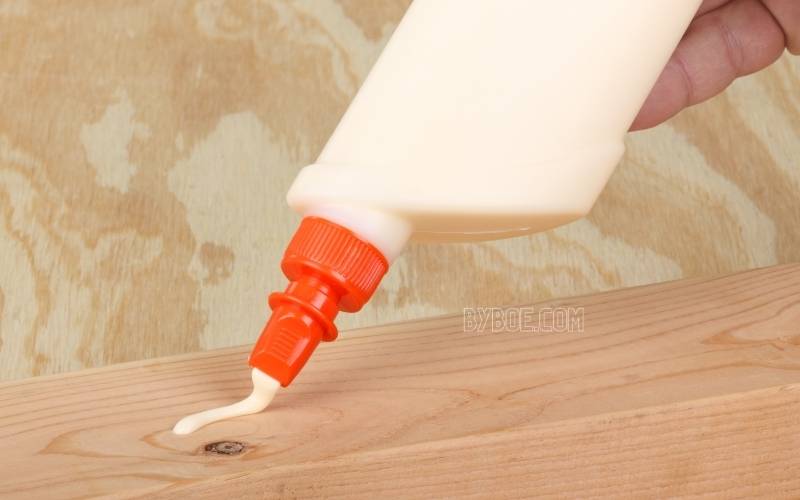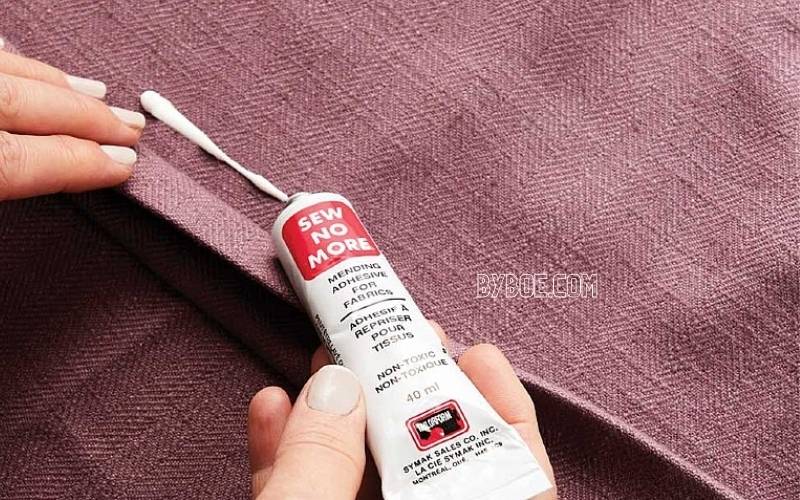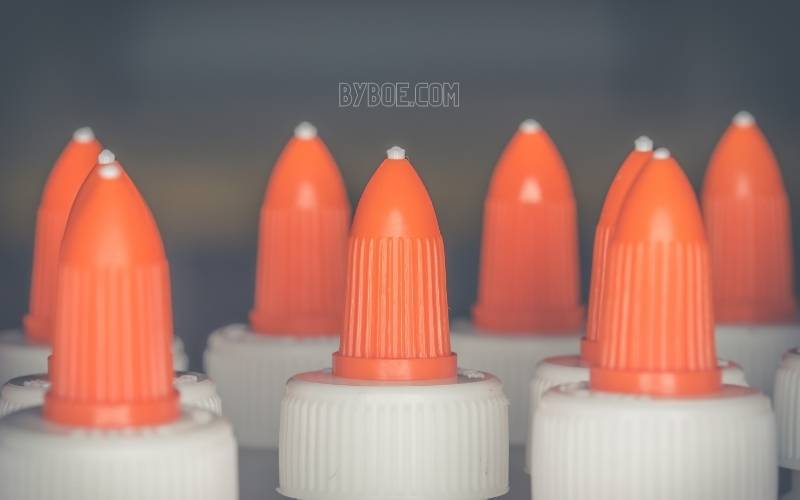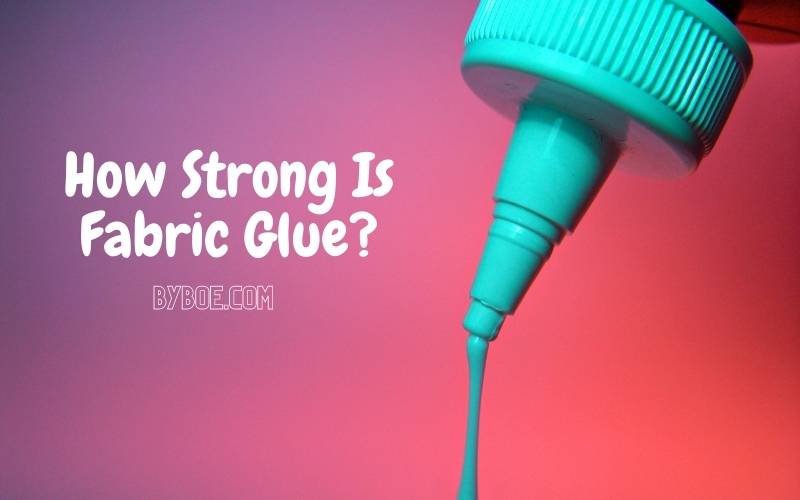How Strong Is Fabric Glue? There is no one definitive answer to this question as the strength of fabric glue can vary depending on the make and brand. However, fabric glue is generally relatively strong and can hold fabrics together securely.
When buying fabric glue for sewing or craft projects, the strength of glue is an essential factor to consider and how much glue you are going to need. Keep reading to know How long does fabric glue lasts on clothes? And tips on how to keep it lastest.
Table of Contents
How Strong Is Fabric Fusion Glue
Fabric glues can only create permanent bonds under certain conditions, but they are usually temporary glue. Fabric glues are susceptible to deterioration when exposed to heat, water, and chemicals like detergents. The glue will weaken as it is washed.

Most fabric glues can be used once adequately cured and applied correctly. It will last for around five to six washes before it begins to fall apart.
If you don’t wash your fabric or put too much strain on the glue, it can last for an indefinite amount of time.
Your fabric glue’s strength will vary depending on:
Type of permanent fabric glues used. There are many brands and types of fabric glues. The effectiveness of each one will depend on the fabric and conditions they are being used on.
It is essential to know what type of material you are gluing together. Different glues work best with other fabrics. Latex-based fabric glues work well with porous fabrics such as wool and cotton.
Tips to Make Fabric Glue Last Longer

Let it Cure Completely
To make your fabric glue last longer and more robust, ensure it is appropriately set and cured completely. This means following the manufacturer’s instructions. Each brand will have a different curing time.
To ensure maximum strength, make sure you follow all instructions.
Use the Right Fabric Glue
Specific types of fabric glue hold different fabric types together more securely.
A latex glue-like Tear Mender Fabric Glue is best for cotton, silk, denim, and other natural fabrics.
Fabri-tac Fabric Glue is the best glue for synthetic fibers like nylon and polyester.
Fiebing’s Leathercraft cement is an excellent choice for leatherwork.
Clamp or Hold the Fabric Down Whilst Curing
It is vital to hold the fabric in position while the glue sets. Material can move quickly, slowing down the curing process or causing the fabric to develop incorrectly.
This is why you can use clothespins, clothespegs, or even a heavy object to hold the fabric in place until the glue dries.
Apply Thins Coats
Fabric glues that work well when used sparingly are best applied in thin coats. You can damage the fabric by applying too much glue.
Avoid Washing It
Avoiding frequent washing is the best way to ensure that your fabric glue stays solid and durable. If you cannot avoid washing your fabric glue, you should wash it with a gentle cycle in warm water.
Ensure the Fabric is Free from Dirt and Residue
Fabric glue can be affected by dirt, dust, and other sediments. Before applying fabric glue, ensure that your material is dry and clean.

Which Is The Strongest Fabric Glue?
As we’ve seen, permanent fabric glue is stronger than the other types. We will respond to your product-specific questions as soon as possible.
Before you reach for the glue bottle, let us briefly go over what factors affect the strength and expectations.
Type of Fabric
Fabric is the first thing that determines how strong a fabric adhesive will be. Different fabric glues react differently to others.
The strong bond is made with absorbent woven fabrics such as cotton and cotton weaves. These include satin, flannel denim, corduroys, Georgette, Georgette, muslin, and denim. Woven fabrics allow permanent fabric glue through the weave to permanent bond efficiently.
Cotton is flexible, accepting, and receptive. This type of fabric is the best for fabric glues to perform their best.
It is essential to verify which fabrics glue can be used for and whether they can bond fabric with other materials such as wood, glass, and cardboard.
Some formulas can only be used on synthetic fabrics such as nylon, acrylic, and polyester. Others are specifically labeled fabric glue for natural fibers.
Fabric glue’s strength will also depend on the fabric’s density. Less fussy materials will be lighter and more flexible. They might bond more quickly than heavy fabrics like leather and canvas.
These fabrics are thicker and more fragile, requiring stronger glue to support their weight. The fabric glue must be strong enough to bond the material. It will be labeled super or industrial-grade fabric adhesive.
Joining
Fabric glue has many uses. The strength of fabric glue varies depending upon the joining.
Any fabric glue designed for these materials will hold up well if used to join fabric to a flat, rigid surface such as cardboard, stock card, or wood.
This large area is a huge help. Fabric-wrapped decor can be used to fix or stand.
Flexible joinings such as fabric-to fabric fusion in clothing or bedding require a lot of movement. The glue can crack or become brittle if it is not made to be flexible after drying.
Polyurethane-based fabric adhesives are the best for fabric-to-fabric bonding, where stiffness is not an option. This glue will give you both strength and flexibility.
Stress
Fabric glue bonds are subject to any weight, tension, or stress. This puts their strength to the test.
Let’s say you need to repair seams on articles that are likely to be used and washed frequently. Only the strongest permanent fabric glue can handle all motion and agitation. This is particularly true for seams at the elbows, knees, and underarms of pants.
Flat fabric-to-fabric, such as repair patches, badges, and embroidery patches, don’t have to be subjected to as much tension as seams. They are therefore less dependent on fabric glue.
Small decorations are the same. Featherweight embellishments include rhinestones, flat back pearls and flowers, lace, ribbons, and other popular items. They don’t put too much stress on the bond.
Let’s get back to the original question: Which fabric glue is strongest? the strongest permanent adhesive for fabric is available. It is environmentally friendly and can fuse with many fabrics and non-cloth materials.
Beacons Fabri-Tac is also available. It’s just as good and as effective as Tearmender. Roxanne Baste is the best temporary fabric glue if the USA is a spray adhesive that can be used instead of a liquid adhesive.
It would help if you learned a lot about fabric adhesive and what you can expect to do with it depending on your purpose. Let’s quickly summarize the lesson: how strong is fabric glue. It is not clear how strong fabric glue can be.
Permanent glue is more vital than temporary fabric glue. However, even different brands of permanent fabric glue have different strengths.
Their performance strength is also dependent on their type of application and joins, what kind of fabric they are glued to, how much tension it experiences, and how frequently it comes in contact with water.
Fabric glue bonds are more susceptible to wearable, mobile, heavy, and washable parts than the non-washable and non-wearable lightweight and rigid components.
Conclusion
Fabric glue is a great way to keep your clothes together. It is strong and will hold the fabric together. It is also easy to use and comes in a tube. If you are looking for the best fabric glue, then check out our best list right now.

